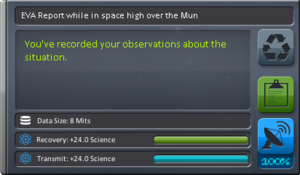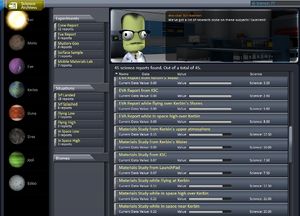Difference between revisions of "Science/ja"
Kspjptrans (talk | contribs) (→サイエンスポイント乗数) |
Kspjptrans (talk | contribs) (→Science Archives) |
||
| Line 247: | Line 247: | ||
== Science Archives == | == Science Archives == | ||
| − | [[File:Science archive.jpg|thumb|right| | + | [[File:Science archive.jpg|thumb|right|Science Archive画面]] |
| − | + | [[Research and Development/ja|Research and Development]]画面左上にある"Science Archive"タブを選択することで過去の実験記録を閲覧することが出来る。 | |
| − | + | 各項目の"value"バーはその実験記録の完成度を示しており、バーが一杯になるまでは繰り返し同じ実験をすることで残りのScienceポイントを獲得することが出来る。またフィルタリング機能を使用してBiomes別、Situations別に未調査の実験を洗い出すことも出来る。 | |
[[Category:Career-specific features]] | [[Category:Career-specific features]] | ||
[[Category:Index/ja]] | [[Category:Index/ja]] | ||
Revision as of 00:33, 13 September 2014
Science, sometimes called science points, is needed to unlock new parts in the technology tree when playing in the Career or Science modes (Sandbox starts with all parts unlocked). Science is obtained by performing different scientific activities in different situations and biomes (where available), then either returning to Kerbin or transmitting the activity data home with an antenna.
In addition to the facts collected on this page, you can follow this beginner-friendly Science tutorial.
Contents
Situations
Situations(実験状況)は天体に対する機体や緑の相対的位置で決まる。"Situations"には6つの区分があり、実験内容や天体によってはその一部しかない場合もある。
- SrfLanded: 地表。操作対象が地表に密着している状態。
- SrfSplashed: 着水。操作対象が液体に浸っている状態。(海や湖など)
- Flying Low: 低空。大気圏のうち低高度で操作対象が接地していない状態。
- Flying High: 高空。大気圏うち高高度の上空。
- In Space Low: 低高度宇宙。大気が無い状態の任意の高度で操作対象が接地していない状態。
- In Space High: 高高度宇宙。大気が無い状態で重力圏以内の宇宙空間。
大気の存在は"Flying Low""Flying High"2つの区分の必要条件で、"PresMat Barometer""Sensor Array Computing Nose Cone"2種の動作条件でもある。Also, KSP only considers a craft (or Kerbal) to be flying in an atmospheric region if it is on a sub-orbital trajectory. For example, taking readings while aerobraking in the upper atmosphere will return data for the "In Space Low" situation instead of "Flying High" even if the altitude is below the edge of space.
Biomes
Biomes(バイオーム)はKSPにおいては天体地表の地形区分を指す。各バイオームにはそれぞれ別の実験結果が割り当てられており、さらにバイオームごとに別のSituationも割り当てられる。
現時点[outdated]ではKerbinとその衛星Mun、Minmusのみ詳細なバイオームが実装されているが、Squadは他の天体のバイオームも更新を予定していると表明している。
Activities
This is an overview of all science activities which can be performed and how results differ by biome and situation. Activities performed within one sphere of influence(SOI) have no effect on the Science Points that can be earned doing science activities within the SOI of any other celestial body.
Possible combinations of Activity, Situation, and Biome
The top row of the chart names each Activity; the left hand column shows the six possible Situations.
Each intersection shows whether the Activity is possible for a given Situation and, if so, whether it differs by Biome or gives one Global result for the entire celestial body.
Activities and situations requiring an atmosphere are italicized and colored.
| Kerbonaut | Capsule | Modules | ||||||||
|---|---|---|---|---|---|---|---|---|---|---|
| Surface Sample | EVA Report | Crew Report | Mystery Goo™ Containment Unit | SC-9001 Science Jr. | 2HOT Thermometer | PresMat Barometer | GRAVMAX Negative Gravioli Detector | Double-C Seismic Accelerometer | Sensor Array Computing Nose Cone | |
| Surface: Landed | Biome | Biome | Biome | Biome | Biome | Biome | Biome | Biome | Biome | Biome |
| Surface: Splashed | Biome | Biome | Biome | Biome | Biome | Biome | Biome | Biome | — | — |
| Flying Low | — | Biome | Biome | Global | Global | Biome | Global | — | — | Biome |
| Flying High | — | Global | Global | Global | Global | Global | Global | — | — | Biome |
| In Space Low | — | Biome | Global | Global | Global | Global | — | Biome | — | — |
| In Space High | — | Global | Global | Global | Global | — | — | Biome | — | — |
Crew
The following Activities are performed by Kerbals during an EVA or from within a crewed command module.
Surface Sample
Surface Samples can be taken by kerbonauts when performing an EVA on the ground or in water of a celestial body. The results vary by biome and situation (landed or splashed) just as with craft.
EVA Report
EVA Reports are done by kerbonauts on an EVA. Like crew reports they give different results depending on altitude and biome (if performed low enough). Only one EVA Report per biome/situation combination is necessary. The easiest ways to take a Flying Low report are to jump from the surface, or hang onto a ladder whilst landed.
A kerbonaut can only take and hold one EVA Report at a time without storing it in a Command Pod, though reports retrieved from a Command Pod have no limitations on how many of a type can be carried.
Crew Report
Crew Reports can be created in any manned command pod. Reports uniquely differ between celestial body and situation. Because the transmission efficiency is 100%, repeating them or transmitting them multiple times yields no additional Science.
If a command pod has taken a Crew Report but not transmitted it, it cannot take a new report even when in a new situation, biome, or sphere of influence. This limitation can be circumvented by having a kerbonaut on EVA "take data" from the command pod. Even if they store the data in the same command pod it was taken from, the Crew Report will be treated as just another piece of data to store. A second Crew Report can be taken even in exactly the same spot; no additional points are yielded by duplicate Crew Reports though.
Modules
Experiments done by separate parts like the Mystery Goo™ Containment Unit behave similarly to Crew Reports. They may be performed in different flight phases and on different celestial bodies returning different results. Each module can only store one result at a time, but a result can be sent home with an antenna to allow the experiment to be performed again under the same or under new conditions. Data can also be extracted from the module by a kerbonaut during an EVA. There is a penalty for transmitting data home instead of recovering the module to Kerbin.
Since バージョン 0.23, transmitting or collecting data renders the Mystery Goo™ Containment Unit and SC-9001 Science Jr. disabled for the remainder of a flight. If the craft has (or can be docked with) a fully crewed lab, it can reset those modules at a cost of time and electric charge.
実験一覧表
| 実験 | 必要パーツ | 技術LV | 基礎ポイント | 最大ポイント | データ量 | 伝送効率 | ラボボーナス | ラボ電力消費(E) |
|---|---|---|---|---|---|---|---|---|
| Serface Sample | 宇宙飛行士 | 1 | 30 | 40 | 1 | 25% | +12% | 300 |
| EVA Report | 宇宙飛行士 | 1 | 8 | 8 | 1 | 100% | +0% | 0 |
| Crew Report | 有人司令ポッド | 1-8 | 5 | 5 | 1 | 100% | +0% | 0 |
| Mystery Goo Observation | Mystery Goo™ Containment Unit | 2 | 10 | 13 | 1 | 30% | +15% | 100 |
| Materials Study | SC-9001 Science Jr. | 4 | 25 | 32 | 1 | 20% | +10% | 250 |
| Temperature Scan | 2HOT Thermometer | 5 | 8 | 8 | 1 | 50% | +25% | 80 |
| Atmospheric Pressure Scan | PresMat Barometer | 6 | 12 | 12 | 1 | 50% | +25% | 120 |
| Seismic Scan | Double-C Seismic Accelerometer | 7 | 20 | 22 | 2.5 | 45% | +22% | 500 |
| Gravity Scan | GRAVMAX Negative Gravioli Detector | 8 | 20 | 22 | 3 | 40% | +20% | 600 |
| Atmosphere Analysis | Sensor Array Computing Nose Cone | 8 | 20 | 24 | 10 | 35% | +17% | 2000 |
アンテナを使用した場合の獲得Scienceポイントは伝送効率に応じて制限される。損失無しにScienceポイントを獲得するには実験結果を直接持ち帰る必要がある。
Craft recovery
Recovering a craft after it landed on Kerbin also yields science points by itself. Its value depends on how far the craft flew. Recovering a craft after a suborbital flight returns less valuable (but different) results than one which orbited the Mun, for example.
The returned value appears to be 5 * (surfaces visited + bodies orbited).
Scienceポイント倍率
天体にはそれぞれScienceポイント倍率が設定されており、それに応じて獲得Scienceポイントが算出される。バイオームごとの差異は無い。
以下の表に記載されている境界高度は低空と高空、低高度宇宙と高高度宇宙の境界高度を指している。高空の高度上限は各天体の大気圏上限と同値、高高度宇宙の高度上限は重力圏の範囲と同値である。
| 天体表面 | 大気圏内 [note 1] | 宇宙 | ||||||||||
|---|---|---|---|---|---|---|---|---|---|---|---|---|
| 天体 | 着地 | 着水 | 倍率 | 境界高度 | 倍率 | 境界高度 | 帰還回収 | |||||
| カーボル (Kerbol) | N/A | N/A | 1× | 1× | 18 km | 600 km | 11× | 2× | 1000 Mm | 4× | ||
| モーホー (Moho) | 10× | N/A | N/A | N/A | N/A | N/A | 8× | 7× | 80 km | 7× | ||
| イブ (Eve) | 8× | 8× | 6× | 6× | 22 km | 90 km | 7× | 5× | 400 km | 5× | ||
| ギリー (Gilly) | 9× | N/A | N/A | N/A | N/A | N/A | 8× | 6× | 6 km | 6× | ||
| カービン (Kerbin) | 0.3× | 0.4× | 0.7× | 0.9× | 18 km | 70 km | 1× | 1.5× | 250 km | 1× | ||
| ムン (Mun) | 4× | N/A | N/A | N/A | N/A | N/A | 3× | 2× | 60 km | 2× | ||
| ミンマス (Minmus) | 5× | N/A | N/A | N/A | N/A | N/A | 4× | 2.5× | 30 km | 2.5× | ||
| ドゥナ (Duna) | 8× | N/A | 5× | 5× | 12 km | 50 km | 7× | 5× | 140 km | 5× | ||
| アイク (Ike) | 8× | N/A | N/A | N/A | N/A | N/A | 7× | 5× | 50 km | 5× | ||
| ドレス (Dres) | 8× | N/A | N/A | N/A | N/A | N/A | 7× | 6× | 25 km | 6× | ||
| ジュール (Jool) | N/A | N/A | 12× | 9× | 120 km | 200 km | 7× | 6× | 4 Mm | 6× | ||
| レイス (Laythe) | 14× | 12× | 11× | 10× | 10 km | 50 km | 9× | 8× | 200 km | 8× | ||
| ヴァル (Vall) | 12× | N/A | N/A | N/A | N/A | N/A | 9× | 8× | 90 km | 8× | ||
| タイロー (Tylo) | 12× | N/A | N/A | N/A | N/A | N/A | 10× | 8× | 250 km | 8× | ||
| ボップ (Bop) | 12× | N/A | N/A | N/A | N/A | N/A | 9× | 8× | 25 km | 8× | ||
| ポル (Pol) | 12× | N/A | N/A | N/A | N/A | N/A | 9× | 8× | 22 km | 8× | ||
| イーロー (Eeloo) | 15× | N/A | N/A | N/A | N/A | N/A | 12× | 10× | 60 km | 10× | ||
- ↑ Suborbital flight necessary for atmosphere readings, having the periapsis inside the atmosphere start is not sufficient.
Science Archives
Research and Development画面左上にある"Science Archive"タブを選択することで過去の実験記録を閲覧することが出来る。
各項目の"value"バーはその実験記録の完成度を示しており、バーが一杯になるまでは繰り返し同じ実験をすることで残りのScienceポイントを獲得することが出来る。またフィルタリング機能を使用してBiomes別、Situations別に未調査の実験を洗い出すことも出来る。


